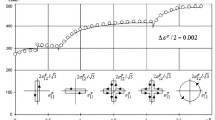Summary
A class of materials that fracture in a stable progressive manner and recover all deformation on unloading has been described and a theory for such materials has been developed. The theory is similar to hardening plasticity but with the important addition that, subject to certain conditions, the loading function leads to a description of degradation of stiffness as well as an associated flow rule. A generalization of a simple model for isotropic strain-softening is proposed for use in combination with other material idealisations in the analysis of structures of rock, concrete and similar materials.
Résumé
Cet article décrit un groupe de matériaux qui se brisent d'une manière progressive stable et qui reprennent leur forme initiale par décharge élastique, ainsi que la théorie élaborée à leur sujet. Cette théorie est analogue à celle de la plasticité d'écrouissage mais elle démontre en plus que, sous certaines conditions, la fonction définissant la surface de rupture donne aussi la loi d'écoulement et une expression du changement du tenseur des coefficients élastiques. On propose l'utilisation d'une généralisation d'un modèle simple de radoucissement isotrope avec d'autres idéalisations, déjà connues, relatives aux matériaux dans l'analyse des structures des roches, du béton et d'autres matériaux similaires.
Similar content being viewed by others
References
A.A. Griffith,The Phenomena of Rupture and Flow in Solids, Phil. Trans. Roy. Soc.A 221, 163–198, 1920.
C. Gurney andJ. Hunt,Quasi-static Crack Progagation, Proc. Roy. Soc.A229, 508–524, 1967.
J.W. Dougill,Some Remarks on Path Independence in the Small in Plasticity, Quart. Appl. Math.33, No. 3, 233–243, 1975.
A.A. Il'iushin,On the Postulate of Plasticity, Appl. Math. Mech.25, 746–752, 1961. (Translation of Prikladnaya Matematika i Mekhanika, Vol.25 1961, pp. 503–7).
W. Prager,On Elastic, Perfectly Locking Materials, Proc. 11th Int. Conf. Appl. Mechanics, München 1964. (Springer-Verlag, Berlin 1966, pp. 538–544).
D.C. Drucker,A Definition of Stable Inelastic Material, J. Appl. Mech.26, (Trans. ASME Vol. 81, Series E), 101–106, 1959.
D.C. Drucker,Some Implications of Work Hardening and Ideal Plasticity, Quart. Appl. Math.7, No. 4, 411–418, 1950.
D.C. Drucker,Stress-strain-time Relations and Irreversible Thermodynamics, Proc. 1962 IUTAM Symposium on Second Order Effects in Elasticity, Plasticity and Fluid Dynamics; Eds. D. Abir and M. Reiner. Pergamon Press, Oxford 1964, pp. 331–350.
R. Hill,The Mathematical Theory of Plasticity. Oxford University Press, Oxford 1950.
W.T. Koiter,Stress Strain Relations, Uniqueness and Variational Theorems for Elasticplastic Materials with a Singular Yield Surface. Quart. Appl. Maths.11, 350–354, 1953.
J.L.Sanders Jr. Plastic Stress-strain Relations Based on Linear Loading Functions, Proc. 2nd U.S. Nat. Congress Appl. Mechanics 1954, pp. 455–460.
O.C. Zienkiewicz, G.C. Nayak andD.R.J. Owen,Composite and ‘Overlay’ Models in Numerical Analysis of Elasto-Plastic Continua. Proc. Int. Symp. Foundation of Plasticity, Warsaw August 30–September 2, 1972. Ed by A. Sawczuk, Noordhoff, Gröningen 1972, pp. 107–123.
J.P. Berry,Some Kinetic Considerations of the Griffith Criterion for Fracture—II Equations of Motion at Constant Deformation. Mech. Phys. Solids.8, 207–216, 1960.
W.R. Waversik andC. Fairhurst,A Study of Brittle Fracture in Laboratory Compression Experiments, Int. Rock Mech. & Mining Sci.7, No. 5, 561–575, 1970.
N.J.Burt andJ.W.Dougill,Progressive Failure in Uni-directional Extension Tests on a Model Heterogeneous Material, in preparation.
S.B. Batdorf andB. Budiansky,A Mathematical Theory of Plasticity Based on the Concept of Slip. N.A.C.A. Techn. Note No. 1871, Washington 1949, pp. 33.
B. Budiansky andT.T. Wu,Theoretical Prediction of Plastic Strains of Polycrystals, Proc. 4th U.S. Nat. Congress Appl. Mechanics. ASME, Vol.2, 1175–1185, 1962.
Author information
Authors and Affiliations
Rights and permissions
About this article
Cite this article
Dougill, J.W. On stable progressively fracturing solids. Journal of Applied Mathematics and Physics (ZAMP) 27, 423–437 (1976). https://doi.org/10.1007/BF01594899
Received:
Issue Date:
DOI: https://doi.org/10.1007/BF01594899




